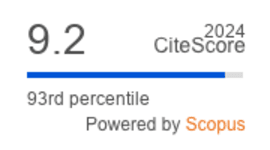Evaluation of antibiofilm activity of Thymus syriacus essential oil against clinically isolated MDR bacteria
DOI:
https://doi.org/10.36877/pmmb.a0000284Abstract
Finding alternative strategies to confront bacterial resistance is an urgent need. Biofilm-forming bacteria have become a serious problem in medicine and industry. Bacteria can use biofilm as a mechanism of resistance against antibacterial drugs and avoid the immune system. The aim of this study was to evaluate the antibacterial activity of Thymus syriacus (T. syriacus) essential oil in a solid and liquid medium and to study its antibiofilm formation activity. The T. syriacus essential oil was extracted from the aerial parts of the plants. The minimum inhibitory concentrations (MIC) measurements were used to identify the antibacterial activity of the essential oil against multidrug-resistant strains Pseudomonas aeruginosa (P. aeruginosa), Klebsiella pneumonia (K. pneumonia), Streptococcus pneumonia (S. pneumonia) isolated clinically from blood infections. The microtiter plate was used in order to quantify biofilm formation by bacteria. The minimum inhibitory concentration (MIC) against the three clinically isolated strains (P. aeruginosa, K. pneumonia, S. pneumonia) were (3.12, 1.56, 3.12 µL/mL) respectively. The formation of biofilm by (P. aeruginosa, K. pneumonia, S. pneumonia) was reduced up to (43%, 50%, 60%) respectively, when the essential oil was applied at MIC concentrations for each strain. The observed antibacterial activity of T. syriacus essential oil was significant against antibacterial-resistant strains and antibiofilm formation activity was identified. The novelty of this study is we confirmed that the essential oil of T. syriacus exhibited not just antibacterial properties but also antibiofilm formation effect. More studies are needed in order to continue studying this oil and evaluate its other medicinal properties and toxicity.
Downloads
Published
How to Cite
Issue
Section
License
Copyright (c) 2022 Basem Battah, Anas Rajab, Lama Shbibe, Jagjit Singh Dhaliwal, Khang Wen Goh, Long Chiau Ming, Yaman Kassab, Abdelhakim Bouyahya, Mahibub Mahahamadsa Kanakal, Chadi Soukkarieh

This work is licensed under a Creative Commons Attribution-NonCommercial 4.0 International License.
Author(s) shall retain the copyright of their work and grant the Journal/Publisher right for the first publication with the work simultaneously licensed under:
Creative Commons Attribution-NonCommercial 4.0 International (CC BY-NC 4.0). This license allows for the copying, distribution and transmission of the work, provided the correct attribution of the original creator is stated. Adaptation and remixing are also permitted.

This broad license intends to facilitate free access to, as well as the unrestricted reuse of, original works of all types for non-commercial purposes.
The author(s) permits HH Publisher to publish this article that has not been submitted elsewhere.



.png)

.jpg)
